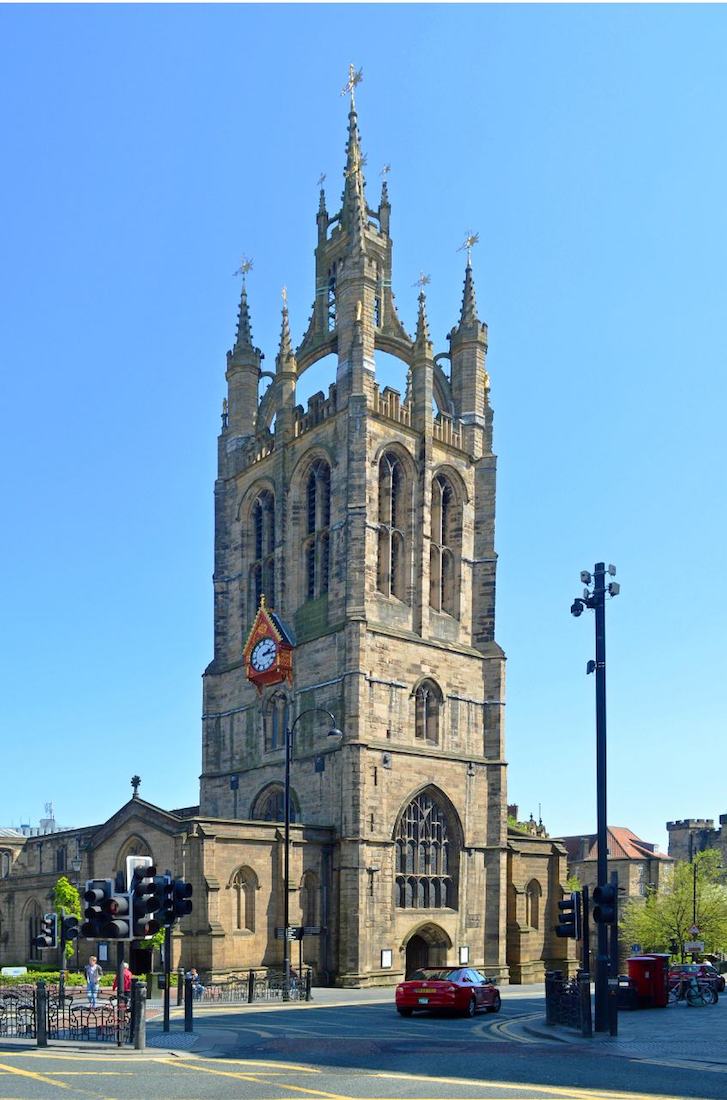WELCOME TO
NEWCASTLE CATHEDRAL
ENGLAND ANGLICAN
PAUL SCOTT

The Cathedral of St Nicholas began life a long time ago as a parish church. As the plan shows, it is no longer square – if it ever was! There are signs of an original cruciform shape, although a smaller transept appears at the West end (bottom). However, various additions have taken away any symmetry that was once present.
Starting at the Northwest corner (bottom left) we shall circumnavigate the Cathedral in an anti-clockwise direction, before exploring the interior. Missing from this plan is the Cathedral hall, linked at the top left corner.
Brief historic notes of the Cathedral are given in the main text. Alternatively a short history is given below. If you want to begin your tour of the Cathedral immediately, tap / click on START .
You can access intermediate points in the tour by a tap / click on the following links:
NOTE ON MAGNIFYING IMAGES
With this website format the images are large enough for most purposes. If there is a need for greater magnification of an image, go to the identical photo on
https://www.flickr.com/photos/paulscottinfo/albums
and use Command - + (Mac) or Windows - + (Windows).
HISTORY
The cathedral is named after St Nicholas, the patron saint of sailors and boats. This may reflect the cathedral’s position on the northern heights above the River Tyne. It was originally a parish church, built in 1091. It was built close to the line of Hadrian’s Wall through Newcastle, which may have passed through the churchyard to the south, but unfortunately the exact location of its line through the very centre of the city is currently lost. Close to the south of the cathedral is Newcastle Castle, which gave the city its name, and which was itself built on the site of the Hadrian’s Wall fort of Pons Aelius. The Norman church was destroyed by fire in 1216 and the present church was completed in 1350.
The most famous incumbent of the cathedral was the Scottish reformer John Knox, who served as minister from late 1550 until 2 February 1553.
In the mid-19th century Newcastle experienced a huge increase in its population, leading to the construction of over 20 new churches in the suburbs. As Newcastle continued to grow, so did its need for a diocese separate from Durham, and so in 1882 the Diocese of Newcastle was formed, with St Nicholas’s as its cathedral. With this, Newcastle was designated a City in the same year.
The cathedral is notable for its unusual lantern spire, which was constructed in 1448. For hundreds of years, it was a main navigation point for ships using the River Tyne. At its base the tower measures 36 ft 9 in (11.20 m) by 35 ft (11 m) and it is 196 ft 6 in (59.89 m) from the base to the top of the steeple.
On each corner of the lantern are gilded statues: Adam eating the apple, Eve holding out the apple, Aaron dressed as a bishop, and David holding a harp. Following work on the street in the 1860s the tower was found to be cracking and tilting, so two porches were added to buttress the structure. Since then the tower has settled and the ornate wooden font cover, which is suspended from the tower inside, does not hang in line with the font.
The interior of the church was badly damaged by Scottish invaders during their brief occupation of the city in 1640, and in 1644, during a nine-week siege, Scottish invaders threatened to bombard the lantern tower, but were deterred when the mayor Sir John Marley put his Scottish prisoners in it. The tower was repaired in September 1645, 1723 and 1761. A lightning conductor was added in 1777.
In 2020, the nave of the cathedral is largely closed to visitors on account of building work, as part of the Common Ground in Sacred Space heritage project. The east end of the cathedral remains in use and can be accessed via a courtyard on the north side of the building. The current works entail removing the pews, installing underfloor heating, restoring up to 130 ledger stones (gravestones), improving the cathedral gardens, and adding an east entrance to the building.



